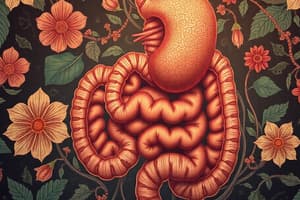Podcast
Questions and Answers
Which of the following is NOT a risk factor for developing rhabdomyolysis when taking statins?
Which of the following is NOT a risk factor for developing rhabdomyolysis when taking statins?
- Use of certain medications
- Small body frame and frailty
- Moderate physical exercise (correct)
- Chronic kidney disease
What is the average percentage reduction in LDL cholesterol achieved by Ezetimibe?
What is the average percentage reduction in LDL cholesterol achieved by Ezetimibe?
- 30%
- 18% (correct)
- 12%
- 25%
Which of the following medications can increase the risk of myopathy when taken with statins?
Which of the following medications can increase the risk of myopathy when taken with statins?
- Fibrates (correct)
- Beta blockers
- Antihistamines
- Aspirin
In what percentage of patients are adverse side effects leading to discontinuation of statin therapy reported?
In what percentage of patients are adverse side effects leading to discontinuation of statin therapy reported?
What is defined as muscle symptoms with marked elevation in CK at 50 times the upper limit of normal?
What is defined as muscle symptoms with marked elevation in CK at 50 times the upper limit of normal?
What additional effect does Ezetimibe have on HDL cholesterol levels?
What additional effect does Ezetimibe have on HDL cholesterol levels?
Which of the following is LEAST likely to be an adverse effect associated with statins?
Which of the following is LEAST likely to be an adverse effect associated with statins?
When should pharmacological therapy be considered for patients needing primary prevention?
When should pharmacological therapy be considered for patients needing primary prevention?
What percentage range of triglyceride reduction can niacin achieve?
What percentage range of triglyceride reduction can niacin achieve?
Which niacin formulation is specifically designed to reduce flushing without increasing hepatotoxicity risk?
Which niacin formulation is specifically designed to reduce flushing without increasing hepatotoxicity risk?
Which of the following is a primary effect of fibrates?
Which of the following is a primary effect of fibrates?
What is the maximum recommended daily dose for extended-release niacin?
What is the maximum recommended daily dose for extended-release niacin?
Which statin-related concern is associated with fibrates?
Which statin-related concern is associated with fibrates?
What complication could arise due to fibrate therapy?
What complication could arise due to fibrate therapy?
How long does it typically take to see maximum lipid effects when using niacin?
How long does it typically take to see maximum lipid effects when using niacin?
What is a major limitation of using immediate-release niacin?
What is a major limitation of using immediate-release niacin?
What is the primary benefit of using ezetimibe in patients who do not adequately respond to statin therapy?
What is the primary benefit of using ezetimibe in patients who do not adequately respond to statin therapy?
What should patients be advised to do to prevent constipation while taking bile acid sequestrants?
What should patients be advised to do to prevent constipation while taking bile acid sequestrants?
What is a common adverse effect of statin therapy that a patient should be monitored for?
What is a common adverse effect of statin therapy that a patient should be monitored for?
Which of the following drugs is most likely to be affected by bile acid sequestrants when taken concurrently?
Which of the following drugs is most likely to be affected by bile acid sequestrants when taken concurrently?
What is the time frame for achieving maximum lipid-lowering effects from resins?
What is the time frame for achieving maximum lipid-lowering effects from resins?
How do PCSK9 inhibitors lower LDL cholesterol levels?
How do PCSK9 inhibitors lower LDL cholesterol levels?
What is a unique characteristic of colesevelam compared to other bile acid sequestrants?
What is a unique characteristic of colesevelam compared to other bile acid sequestrants?
What effect do bile acid sequestrants have on triglyceride levels?
What effect do bile acid sequestrants have on triglyceride levels?
Flashcards
Ezetimibe
Ezetimibe
A medication used to lower cholesterol, often in combination with statins.
Statins
Statins
A class of drugs used to lower LDL cholesterol (bad cholesterol) by reducing its production in the liver.
Bile Acid Sequestrants
Bile Acid Sequestrants
Resins that bind to bile acids in the gut, removing them from the body and reducing cholesterol.
LDL Cholesterol
LDL Cholesterol
Signup and view all the flashcards
Triglycerides
Triglycerides
Signup and view all the flashcards
PCSK9 Inhibitors
PCSK9 Inhibitors
Signup and view all the flashcards
LDL Receptor
LDL Receptor
Signup and view all the flashcards
Maximum Effect Time (Ezetimibe)
Maximum Effect Time (Ezetimibe)
Signup and view all the flashcards
Maximum Effect Time (Resins)
Maximum Effect Time (Resins)
Signup and view all the flashcards
Therapeutic Lifestyle Changes
Therapeutic Lifestyle Changes
Signup and view all the flashcards
Statins
Statins
Signup and view all the flashcards
Liver Function Tests (LFTs)
Liver Function Tests (LFTs)
Signup and view all the flashcards
Myopathy (Statins)
Myopathy (Statins)
Signup and view all the flashcards
Rhabdomyolysis (Statins)
Rhabdomyolysis (Statins)
Signup and view all the flashcards
Risk Factors for Rabdomyolysis
Risk Factors for Rabdomyolysis
Signup and view all the flashcards
Ezetimibe
Ezetimibe
Signup and view all the flashcards
Cholesterol Absorption Inhibitors
Cholesterol Absorption Inhibitors
Signup and view all the flashcards
Niacin's effect on LDL
Niacin's effect on LDL
Signup and view all the flashcards
Niacin's general effect on Lipids
Niacin's general effect on Lipids
Signup and view all the flashcards
Niacin formulations
Niacin formulations
Signup and view all the flashcards
Niacin ER (Niaspan)
Niacin ER (Niaspan)
Signup and view all the flashcards
Niacin dosage
Niacin dosage
Signup and view all the flashcards
Fibrates primary effect on triglycerides
Fibrates primary effect on triglycerides
Signup and view all the flashcards
Preferred fibrate with statins
Preferred fibrate with statins
Signup and view all the flashcards
Fibrate Precaution
Fibrate Precaution
Signup and view all the flashcards
Fibrate Side Effects
Fibrate Side Effects
Signup and view all the flashcards
Study Notes
Introduction to Dyslipidemia
- Dyslipidemia is elevated total cholesterol, low-density lipoprotein (LDL) cholesterol, or triglycerides, or a low high-density lipoprotein (HDL) cholesterol
- These abnormalities can lead to coronary, cerebrovascular, and peripheral vascular arterial disease
Lipid Transport and Metabolism
- Cholesterol is a crucial substance made by the body's cells
- It maintains cell structure, aids in bile acid and hormone production
- Triglycerides and phospholipids are also essential lipids
- Lipoproteins (lipid-protein complexes) transport these lipids in the bloodstream
Lipoprotein Classification
- Lipoproteins vary in size and density based on lipid and protein content
- Chylomicrons, VLDL, IDL, LDL, and HDL are different lipoprotein classes
- Their size and density affect their movement during centrifugation
- Lipoproteins are classified by their density: Chylomicrons, VLDL, IDL, LDL, and HDL
Familial Dyslipidemia Types
- Different types of familial dyslipidemia exist, each with distinct characteristics
- Type I: Hyperchylomicronemia (elevated chylomicrons and triglycerides)
- Type IIa: Hypercholesterolemia (elevated LDL cholesterol)
- Type IIb: Combined hyperlipidemia (elevated both LDL and triglycerides)
- Type III: Dysbetalipoproteinemia (elevated IDL remnants)
- Type IV: Hypertriglyceridemia (elevated triglycerides)
- Type V: Mixed hypertriglyceridemia (elevated both triglycerides and cholesterol)
Clinical Presentation and Diagnosis
- Dyslipidemia often asymptomatic, but corneal arcus and xanthomas might be seen in patients
- Extreme elevations of LDL or triglycerides lead to pancreatitis or tuberoeruptive xanthomas
- Lipid profiles (total cholesterol, non-HDL, LDL, HDL cholesterol, triglycerides) are essential screenings for all adults over 20 every 5 years.
- Children with high cholesterol risk factors should be screened too
Indications for Additional Tests
- Tests should be used for conditions that may create lipid irregularities
- Conditions like those in Table 12-2 (specific examples not included in the summary) should be screened
National Lipid Association Classifications
- National Lipid Association provides cholesterol and triglyceride classification levels (in mg/dL and mmol/L). Specific LDL, HDL, total cholesterol ranges are listed.
- Classification is essential for determining risk levels and treatments.
Treatment
- Lifestyle modifications (diet, exercise, weight reduction) are first-line therapies
- These changes should include reducing total fat to 30% of total energy intake, saturated fat to 10% and cholesterol to 300mg daily and increasing fruits, vegetables, fiber, and fish oil intake.
- Medications are considered for high-risk patients or those who do not achieve desired results from lifestyle modifications
Statins
- Statins are widely used lipid-lowering medications.
- Adverse effects listed can include liver problems, muscle weakness, and rare cases of rhabdomyolysis
- Monitoring of liver function tests and creatine kinase levels is important
Cholesterol Absorption Inhibitors
- Ezetimibe reduces LDL cholesterol but can also result in some increase in HDL levels and a slight decrease in triglycerides
- Ezetimibe is primarily used when statin treatment doesn't bring adequate reduction in cholesterol
Bile Acid Sequestrants
- These medications bind to bile acids in the gut, causing these acids to be excreted and resulting in increased LDL receptors and reduced serum cholesterol
Niacin
- Niacin (vitamin B3) is used for lower LDL cholesterol and increased HDL.
- Potential for significant flushing and liver issues.
- Extended-release niacin is better tolerated
Fibrates
- Fibrates primarily lower triglycerides and raise HDL levels.
- Gemfibrozil is a less preferred fibrate when combined with statin for fear of affecting the statin glucuronidation
- Monitoring of liver function tests and creatine kinase levels is essential
Omega-3 Fatty Acids
- Omega-3 fatty acids reduce triglycerides and may have additional cardiovascular benefits.Excessive consumption can be problematic for patients on anticoagulants and/or antiplatelets
Studying That Suits You
Use AI to generate personalized quizzes and flashcards to suit your learning preferences.




